Category: Iowa history
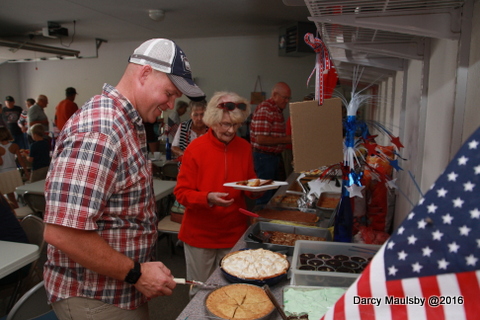
62 Years and Counting: Calhoun County, Iowa, Families Maintain 4th of July Picnic Tradition
Looking for deli fried chicken, bakery pies or other pre-made convenience food? Don’t be surprised if none of it turns up on the massive buffet on the Dial farm during the annual 4th of July picnic. I certainly didn’t see it at this year’s celebration.
“Everyone brings their A game to this event,” said Jolene Schleisman of Lake City, Iowa, who has been attending the 4th of July picnic since she was a child.
While my family has been attending the picnic each July for a few years, the event started in 1954 on Bud Burley’s farm near Lake City. Mike and Dorothy Nichols hosted the party the next year and maintained the tradition until 1981. Then their neighbors, Gerald and Alice Ann Dial, began hosting the celebration on their farm northwest of Lake City. In 2003, the event moved to the Dial’s son Dwight’s farm east of Lake City.
The celebration has been going strong ever since, attracting up to 50 or 60 guests each 4th of July. Along with the fireworks at dusk, the big attraction is the food. Countertops spanning the width of Dial’s two-car garage, along with additional tables, are loaded with homemade fried chicken, roast pork, casseroles, cheese potatoes, baked beans, salads of all kinds, deviled eggs, cakes, pies, candies and more.
“I appreciate how neighbors of all ages enjoy each other’s company,” said Laura Holm, a teacher from Ames who grew up on a farm near Lake City and brings her family back home for the picnic. “I also love the homemade, made-from-the-heart food that comes from friends’ kitchens, not store shelves. This party is about my roots, and I love to teach my kids about these roots.”
At this year’s celebration, Dial’s son, Andy, prepared a number of favorite recipes in honor of his late grandmother, Alice Ann Dial, including her famous lemon me
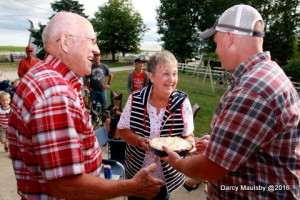
Andy Dial presents a lemon meringue pie to Jim and Joy Angove on their 50th wedding anniversary.
ringue pie. Schleisman also brought a number of classic dishes, including glazed ham balls. Oh yeah, that amazing Iowa classic that makes any picnic a little more memorable.
“To me and the Dial kids, the 4th of July picnic was better than Christmas,” Schleisman said. “I love it that this tradition continues.”
I couldn’t have said it better. Let’s eat!
Savor more Iowa food history
Want more fun Iowa food stories and recipes? Check out my top-selling “Culinary History of Iowa” book from The History Press, and order your signed copy today.
Fried Chicken
Andy Dial used his Grandma Alice Ann Dial’s recipe and his Grandma Dottie Loeck’s cast-iron skillet to make this fried chicken, which is always a star of the 4th of July picnic.
4 dozen chicken hind quarters separated into legs and thighs.
Breading:
5 cups all-purpose flour
1 1 / 2 teaspoons onion powder
1 cup whole wheat flour
1 tsp black pepper
4 tablespoons garlic salt
1 teaspoon paprika
2 tablespoons Lawry’s seasoning salt
Wash:
4 eggs
1 cup whole milk
Combine breading ingredients until mixed thoroughly. Place breading mix into a 9.5-inch pie pan. Beat eggs and milk together until mixed thoroughly. Place egg wash in a separate 9.5-inch pie pan.
Place chicken pieces first in the egg wash until liberally coated; then transfer to the breading mix and turn until coated fully. Once coated with breading, place chicken pieces into hot oil in frying pan. (Andy Dial prefers a cast-iron skillet.) Turn pieces ever 2 to 3 minutes until golden brown all over. Place into roaster pan at 350 degrees to finish cooking through and keep warm until serving time.
Note: To keep chicken crispy, serve immediately after frying.

Glazed Ham Balls are an Iowa classic!
Glazed Ham Balls
Jolene Schleisman of Lake City uses 4 pounds of a ham-ball mix from the locker in Lake City to make these tasty ham balls. Her recipe shows how to make your own ham-ball meat mix, however. These ham balls can be made ahead and frozen (unglazed) to be baked later.
For the ham balls:
2 1 / 2 pounds ground ham
1 1 / 2 pounds ground pork
2 cups instant oatmeal or cracker crumbs
2 eggs, well beaten
1 cup milk
1 teaspoon ground pepper
For the glaze:
1 1 / 2 cups brown sugar
1 / 2 cup apple cider vinegar
1 teaspoon dry mustard
1 / 3 cup Cookies BBQ Sauce
1 / 2 cup water
2 tablespoons honey
Combine ground ham, ground pork, oatmeal or cracker crumbs, eggs, milk and pepper. Shape mixture into balls. Freeze the ham balls to bake later, or place them in a greased, glass baking dish.
To make the glaze, combine brown sugar, apple cider vinegar, dry mustard, BBQ sauce, water and honey in a saucepan. Cook over medium heat until sugar dissolves.
Pour glaze over ham balls. Bake for 1.5 to 2 hours at 275 or 300 degrees. About every 20 minutes, spoon the glaze over the ham balls as they bake. Yield: 32 ham balls
Deviled Eggs
Andy Dial used a recipe from his mother, Jane, to create this potluck favorite.
6 eggs
1 / 16 teaspoon pepper
2 tablespoons mayonnaise
1 / 4 teaspoon paprika
1 teaspoon vinegar
1 / 2 teaspoon dry mustard or 1 teaspoon prepared mustard
1 / 2 teaspoon salt
Slice hard-boiled eggs in half lengthwise. Remove yolks, smash and mix with seasonings. Refill egg whites with seasoned yolk mixture.
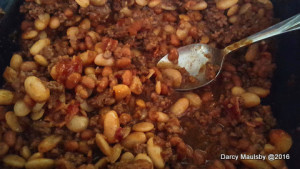
Calico Beans are healthy and always a hit at Iowa picnics.
Calico Beans
Jeanne Devine of Lake City brought along this potluck classic, which she created from a recipe on the Taste of Home website. This recipe can be easily doubled for a larger group.
4 ounces bacon, diced
1 pound lean ground beef (90% lean)
1 / 2 cup chopped onion
1 can (21 ounces) pork and beans
1 can (16 ounces) kidney beans, rinsed and drained
1 can (16 ounces) butter beans, rinsed and drained
1 / 2 cup packed brown sugar
1 / 2 cup ketchup
1 tablespoon cider vinegar
1 teaspoon prepared mustard
1 teaspoon salt
In a large skillet, cook bacon over medium heat until crisp. Remove to paper towels to drain. Discard drippings. In the same skillet, cook beef and onion over medium heat until the meat is no longer pink; drain. Combine the beef mixture, bacon, beans, brown sugar, ketchup, vinegar, mustard and salt. Spoon into a greased 2-quart baking dish.
Bake, uncovered, at 325 degrees for 45 to 60 minutes or until the beans are as thick as desired. Yield: 8-10 servings.
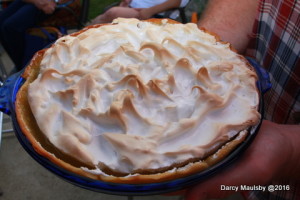
This homemade pie was inspired by Alice Ann Dial’s famous Lemon Meringue Pie.
Lemon Pie
Alice Ann Dial’s signature pie is distinguished by its fresh lemon flavor.
For the filling:
2 cups sugar
4 egg yolks
2 cups water
1 / 2 cup cornstarch
Dash of salt
8 tablespoons fresh lemon juice
2 tablespoons butter
For the meringue:
4 egg whites
8 tablespoons sugar
1 / 4 teaspoon cream of tartar
To mix the pie filling: Blend sugar, egg yolks, water, cornstarch and salt. Cook until the mixture thickens and bubbles up. Remove from heat and add lemon juice and butter. Pour the filling in a pre-baked pie shell made from Alice Ann’s all-purpose pastry mix (see recipe below) and cover immediately with meringue.
To make the meringue, beat the eggs whites until foamy. Add sugar and cream of tartar. Beat slowly until peaks form. Spread on pie, and bake the pie for 20 to 25 minutes at 325 degrees Fahrenheit.
All-Purpose Pastry Mix
Alice Ann Dial kept this all-purpose pastry mix on hand to save time when baking pie.
7 cups flour
4 teaspoons salt
2 cups lard
Combine all ingredients together to create a crumbled consistency, but make sure the mix doesn’t clump together. Store mixture in a covered container in the refrigerator.
For a single crust:
1 1 / 2 cups all-purpose pastry mix
3 tablespoons ice-cold water
For a double crust:
3 cups all-purpose pastry mix
5 tablespoons ice-cold water
Combine the all-purpose pastry mix and ice water until the mixture leaves the sides of the bowl. Then roll out the dough. If you’re making a pie shell for a lemon meringue pie, place the crust in a pie plate and prick the dough with a fork on the bottom and sides before baking the crust at 350 degrees Fahrenheit for 10 to 12 minutes.
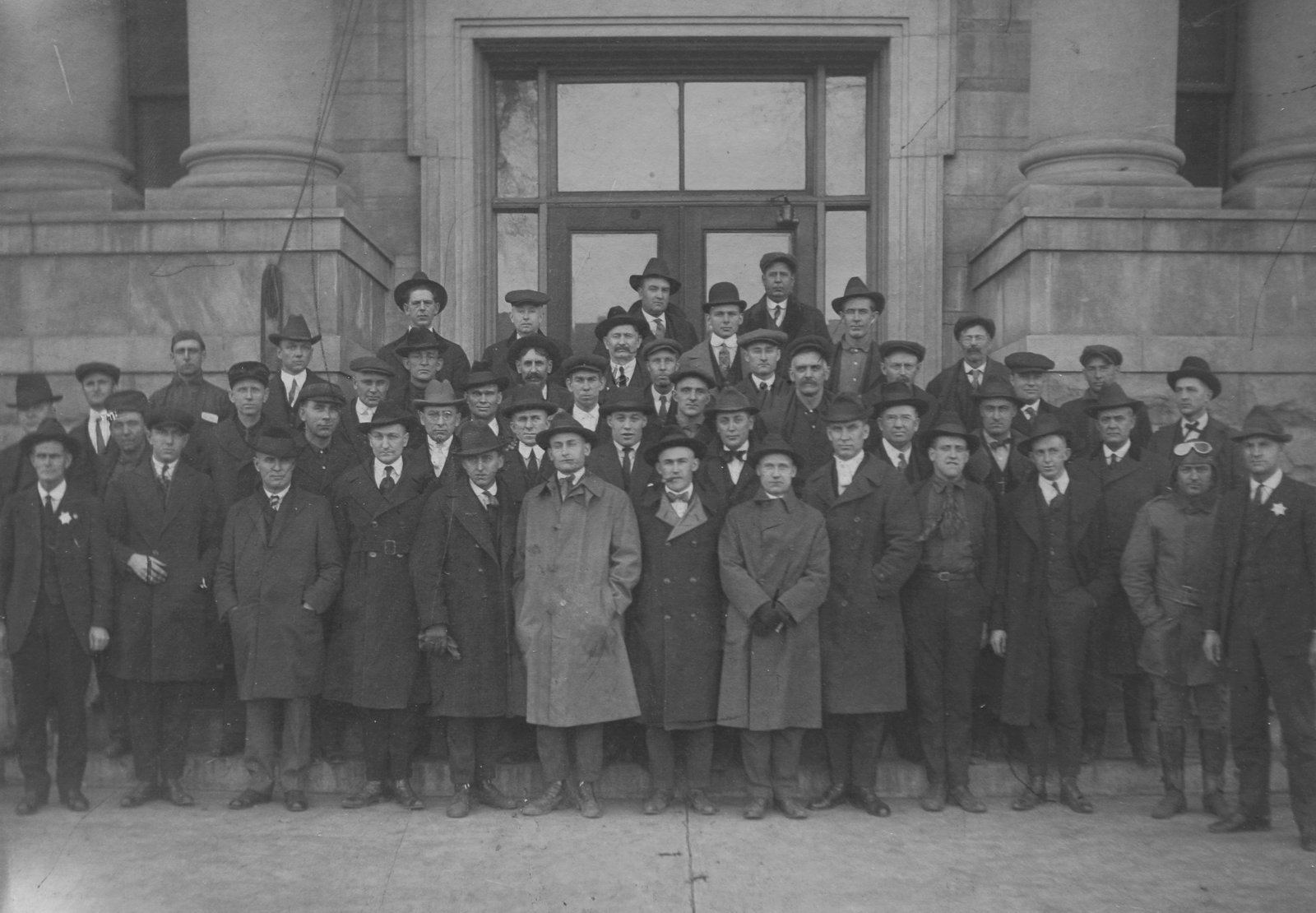
Iowa’s Vigilante Crime Fighters of the 1920s and 1930s
Who were these guys? It’s a question I couldn’t get out of my mind after I discovered a black-and-white image in the Calhoun County Museum in Rockwell City that showed a group of well-dressed men in front of the Calhoun County Courthouse. The only identification on the image, which appeared to be from the late 1920s or early 1930s, were the words “Calhoun County Vigilantes,” along with some long-forgotten names of men I suspect were mayors and other leaders in local towns around the county.
A recent trip to the fascinating “Ain’t Misbehavin:’ The World of the Gangster” exhibit at the Hoover Presidential Library and Museum helped me piece together some potential clues about the story behind this photo.
While bank robbers and swindlers are as old as the banking industry itself, crime sprees shifted into high gear during the early twentieth century. As early as 1912, the Iowa Bankers Association (IBA) decried the “epidemic” of bank burglaries sweeping the state. This proved to be only an inkling of what lay ahead, however. By 1920, burglaries and holdups had increased so dramatically that new protective measures had to be taken.
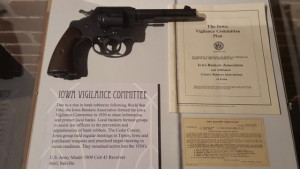
This 2016 display in the “Ain’t Misbehavin:’ The World of the Gangster” exhibit at the Hoover Presidential Library and Museum in West Branch, Iowa, explains more about vigilantes and the role of the Iowa Bankers Association.had increased so dramatically that new protective measures had to be taken.
Although the Iowa Bankers Association (IBA) had previously employed the services of the Pinkerton Detective Agency and the W. J. Burns Detective Agency, the IBA formed Vigilante Committees in the early 1920s to fight the crime wave. In 1921, IBA helped organize 99 county associations and a Vigilance Committee in nearly every city and town in the state to help protect Iowa’s banks.
Vigilantes attracted international attention
The system was a modern reincarnation of the vigilante groups who fought back against horse thieving and cattle rustling during the days of the pioneers. In Iowa, each Vigilance Committee consisted of at least four men in every town where there was a bank. Each committee member was appointed as a deputy sheriff by the county sheriff. In addition, the banks of each county subscribed to at least a $1,000 reward for the apprehension and conviction of bank burglars, plus smaller rewards for telephone operators who helped in the process.
Arrangements were later made with the U.S. War Department so officers in each of Iowa’s County Bankers Associations could purchase guns and ammunition for the members of their Vigilante Committees. The Vigilance Committees were prepared for—and frequently engaged in—gunfights with criminals. At one time, there were 4,303 vigilantes covering 881 banking towns in 84 Iowa counties. “The time of easy dough for the bank bandit has passed,” noted a financial publication that commented on the plan.
Thanks to this system, the bank theft crime wave that had swept Iowa was broken. While losses from bank burglaries totaled more than $225,000 in 1920-1921, more than 100 bank bandits were apprehended from 1920 to 1925. “The plan was such a success that rates for bank burglary and bank insurance in Iowa were dropped to $1 per thousand, while in other states the rates ranged from $4 per thousand in Missouri to $10 per thousand in Oklahoma,” noted Howard E. Bell in his book, “A History of the Iowa Bankers Association.”
Insurance companies across the United States quickly adopted the Iowa Vigilance Committee Plan. A 10 percent discount for both night burglary and daylight holdup insurance rates was automatically granted to banks in any county in the United States that maintained Vigilance Committees.
Iowa’s Vigilance Committee Plan continued to be of national interest for a number of years and generated coverage in a number of magazines and periodicals. As late as 1930, the IBA received an interview request from a publication in Paris, France, that wanted to feature the Vigilance Committee Plan.
IBA takes to the airwaves
Though the vigilantes helped curb crime in the 1920s and early 1930s, the IBA also initiated a low-wave police radio system to bolster its crime prevention efforts. While Des Moines radio station WHO had broadcast news of bank robberies (when requested by the IBA) as early as 1924, it became clear that a radio station devoted solely to police information must be established.
To connect local law enforcement officers with the Iowa Bureau of Criminal Investigation by radio, the IBA purchased a transmitter that was installed in February of 1932 in the organization’s headquarters in the Liberty Building in Des Moines. After the system was tested carefully, station KGHO began regular operations on May 15, 1933.
Later, four other radio stations in Storm Lake, Atlantic, Fairfield and Waterloo (subsequently moved to Cedar Falls) commenced operations to allowed prompt contact with county sheriffs’ offices throughout Iowa. While the IBA transferred the operation of its radio station in 1937 to the State of Iowa and the organization sold its radio equipment, the IBA’s leadership in radio communication helped initiate Iowa’s permanent, statewide police radio system.
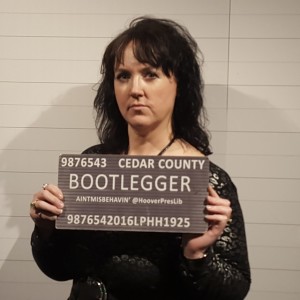
Couldn’t resist getting in on the action at the “Ain’t Misbehavin:’ The World of the Gangster” exhibit at the Hoover Presidential Library and Museum in West Branch, Iowa!
Although radio communication lessened the need for Vigilance Committees, the groups continued to function. The rewards that had been offered by various County Associations were rescinded around 1938, however, as the number of bank holdups and burglaries decreased substantially. As new state crime prevention agencies developed, the suggestion was made to abolish the Vigilance Committees, so banks would no longer have to assume the expense of maintaining the committees. Nevertheless, there were 216 vigilantes who remained active in a number of counties across Iowa as late as 1949.
Although the vigilantes and IBA radio stations are long gone, their legacy remains an intriguing part of Iowa history, including right here in Calhoun County.
Explore more rural Iowa history
Like what you’ve seen here? Sign up today for my blog updates and free e-newsletter, or click on the “Subscribe to newsletter” button at the top of my blog homepage.
Want to discover more stories and pictures that showcase the unique history of small-town and rural Iowa? Perhaps you’d like a taste of Iowa’s culture and favorite recipes. Check out my top-selling “Culinary History of Iowa” book from The History Press and “Calhoun County” book from Arcadia Publishing, and order your signed copies today.
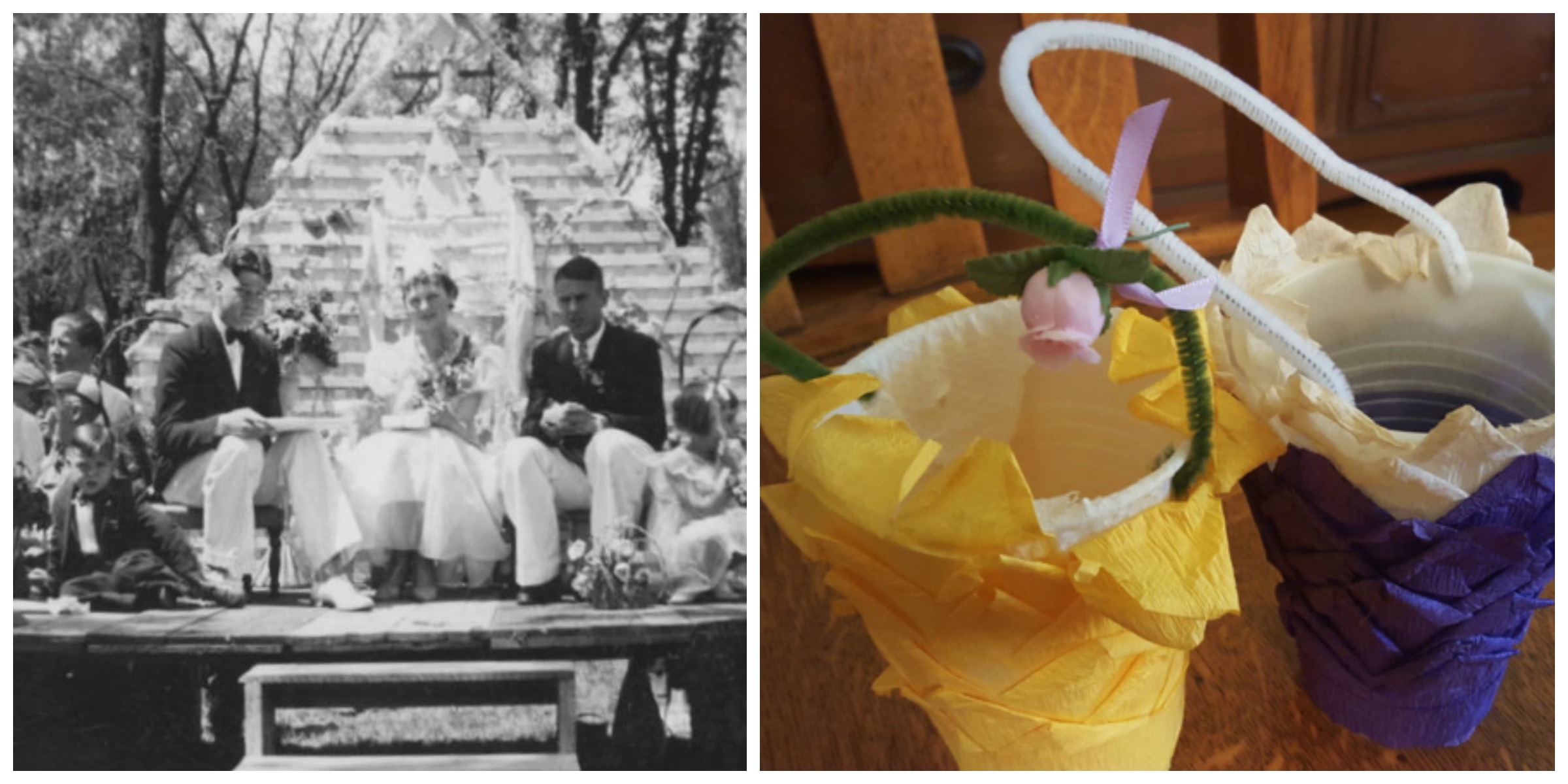
Mayday, Mayday—The Lost History of May Poles and May Baskets in Iowa
Remember the fun, colorful tradition of creating homemade May baskets? (I do.) If you’re a certain age, you may even remember dancing around the May pole. (I don’t). All were once beloved rites of spring here in Iowa and across America.
In many Midwestern communities, May Day celebrations were a highlight of the year. As I researched my book “Calhoun County,” which showcases the history of small-town and rural Iowa through the eyes of those who lived it, I came across a unique picture. Thelma Basler, a member of the senior class of 1935, was elected May Queen by the Lohrville High School student body. In addition to voting for the May Queen
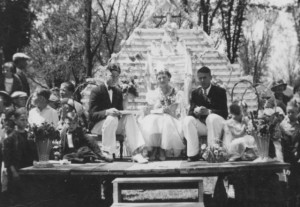
Lohrville High School May Queen, Thelma Basler, 1930s, Lohrville, Iowa
, students decorated the school flagpole in honor of May Day and delivered May baskets to friends.
While these May 1 customs have largely faded from American pop culture, they still endure in pockets of Iowa and beyond, where some of my friends’ children still enjoy making May baskets filled with treats. I started thinking—where did these May Day traditions come from? A little research hinted at something less wholesome than childhood craft projects and school celebrations.
Taming a raucous rite of spring
May pole dancing, for example, dates back to ancient pagan cultures in Europe. Each spring, people would erect a May pole, often of cedar or birch, and dance around it, typically weaving colorful ribbons around the pole as they went, to ensure a fruitful planting season.
An obvious phallic symbol, a May pole was strongly associated with fertility. After the European continent became Christianized, the more raucous elements of May Day celebrations were toned down, but the May pole dance and May baskets survived in a more G-rated form. These customs were carried to America, where they endured well into the twentieth century.
May Day memories from small-town Iowa
In my home town of Lake City, Iowa, Jolene Schleisman recalls weaving ribbons around a May pole in the gymnasium/lunchroom at Lincoln Elementary School in the 1960s. This spring ritual had ended by the time I attended Lincoln Elementary in the 1980s, although I did take square-dancing lessons in
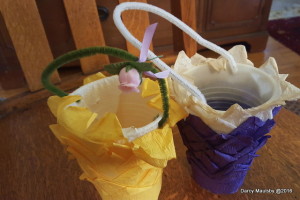
Homemade May baskets created in Lake City, Iowa
music class, a tradition that has now gone the way of the May pole.
During my time at Lincoln Elementary, I did get to experience the joy of making May baskets filled with candies and popcorn to give to friends and family. In the 2015 article “A Forgotten Tradition: May Basket Day,” NPR explained the phenomenon this way:
“As the month of April rolled to an end, people would begin gathering flowers and candies and other goodies to put in May baskets to hang on the doors of friends, neighbors and loved ones on May 1. In some communities, hanging a May basket on someone’s door was a chance to express romantic interest. If a basket-hanger was espied by the recipient, the recipient would give chase and try to steal a kiss from the basket-hanger.”
In Lake City, homemade May baskets became a fundraiser for the ladies of the Presbyterian Church in the mid-twentieth century. Church members including Fanny Howell, principal of Lake City High School from 1928 to 1935, made May baskets out of small paper milk cartons (washed and sanitized with bleach). The ladies decorated each May basket with colorful crepe paper and attached pipe cleaners for handles.
The cheerful baskets were displayed in the front window of McIntyre Furniture store on Center Street, where the smaller baskets could be purchased for a penny apiece. Buyers could then fill the baskets with the treats of their choice and deliver them to friends around town.
Long gone are the penny May baskets, McIntyre Furniture, Fanny Howell and many of the traditions that once defined May 1 in communities across Iowa and beyond. In one respect, however, I’m glad that some major company has not rediscovered May Day, only to mar its simplicity with commercial baskets, cards and trinkets. There’s still something to be said for simplicity and tradition.
Savor more Iowa food history
Want more fun Iowa food stories and recipes? Sign up today for my blog updates and free e-newsletter, or click on the “Subscribe to newsletter” button at the top of my blog homepage.
Check out my top-selling “Culinary History of Iowa” book from The History Press, and order your signed copy today. You can also order my “Calhoun County” Iowa history book, postcards made from my favorite photos of rural Iowa and more at my online store. Thanks for visiting!
